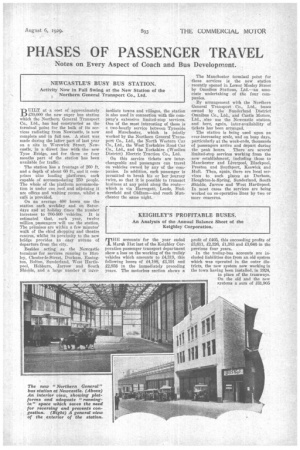PHASES OF PASSENGER TRAVEL
Page 63

If you've noticed an error in this article please click here to report it so we can fix it.
Notes on Every Aspect of Coach and Bus Development.
NEWCASTLE'S BUSY BUS STATION.
Activity Now in Full Swing at the New Station of the Northern General Transport Co., Ltd.
ITILT at a cost of approximately 1.30,000 the new super bus station which the Northern General Transport Co., Ltd., has had constructed as the terminal point for the bulk of its services radiating from Newcastle, is now complete and in full use. A start was made during the latter part of last year on a site in Worswick Street, Newcastle, in a direct line with the new Tyne Bridge, and for three or four months part of the station has been available for traffic.
The station has a frontage of 260 ft, and a depth of about 60 ft., and it corn1) rises nine loading platforms, each capable of accommodating 250 people. The whole of the platform accommodation is under one roof and adjoining it arc offices and waiting rooms, whilst a café is provided.
On an average 400 buses use the station each weekday and on Saturdays and at holiday times the number increases to 700-800 vehicles. It is estimated that, each year, twelve million passengers will use the station. The premises are within a few minutes' walk of the chief shopping and theatre centres, whilst its proximity to the new bridge provides an easy avenue of departure from the city.
Besides acting as the Newcastle terminus for services running to Birtley, Chester-le-Street, Durham, Easington, Bolton, Sunderland, West Hartlepool, Hebburn, Jarrow and South Shields, and a large number of inter mediate towns and villages, the station is also used in connection with the company's extensive limited-stop services. One of the most interesting a these is a two-hourly service between Tyneside and Manchester, which is jointly worked by the Northern General Transport Co., Ltd. the North Western Car Co., Ltd., the ?West Yorkshire Road Car Co., Ltd., and the Yorkshire (Woollen District) Electric Traction Co., Ltd.
On this service tickets are interchangeable and passengers can travel on vehicles owned by any of the companies. In addition, each passenger is permitted to break his or her journey twice, so that it is possible to transact business at any point along the route— which is via Harrogate, Leeds, Fad-. dersfield and Oldham—and reach Manchester the same night. The Manchester terminal point for these services is the new station recently opened in Lower Mosley Street by Omnibus Stations, Ltd.—an associate undertaking of the four companies.
By arrangement with the Northern General Transport Co., Ltd., buses owned by the Sunderland District Omnibus Co., Ltd., and Castle Motors, Ltd., also use the Newcastle station, and here, again, inter-availability of tickets has been arranged.
The station is being used upon an ever-increasing scale, and on busy days, particularly at the week-ends, thousands of passengers arrive and depart during the peak hours. There are several limited-stop services working from the new establishment, including those to Manchester and Liverpool, Blackpool, Preston and Southport, Keswick and Hull. Then, again, there are local services to such places as Durham, Houghton-le-Spring, Sunderland, South 'Shields, Jarrow and West Hartlepool. In most cases the services are being worked on 'co-operative lines by two or more concerns.














































































































